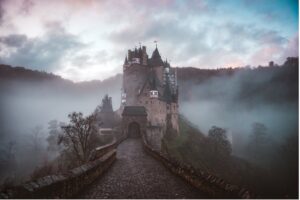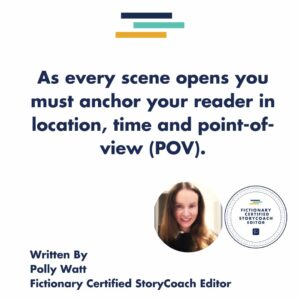What is World-building?
World-building is the construction of story worlds, whether for novels, games, movies or comics.
World-building is often seen as the purview of Science Fiction and Fantasy (SFF)/ speculative genres, though it’s also important for Historical Fiction. Writers of the latter build story worlds based on research, rather than pure imagination.

Steps to Create a New World
First, decide whether you’re building:
A Secondary World
A world in which the story never touches upon our own universe. You’ll find these in:
- High fantasy epics: The Lord of the Rings, Game of Thrones.
- Space Opera Sci-Fi: Dune, Star Wars.
A Version of our Real World
A world with magic/new scientific inventions/paranormal activities etc. You’ll often find this is:
- Dystopian: 1984
- Post-Apocalyptic: Station Eleven
- Historical Fantasy: The Book Thief
- Urban Fantasy: American Gods
- Paranormal: Twilight
- Hard Sci-fi: The Martian
- Soft Sci-Fi: The Time Traveller’s Wife
- Steampunk: Twenty-Thousand Leagues Under the Sea
- Alternative History: Fatherland
A Combination of Both
A mixture of both, often with Portals in between (hence the term, portal fantasy). Examples include:
- Children’s/ YA novels: E.g., Harry Potter and His Dark Materials (these feature portals between the real and imaginary worlds)
- Adult novels: E.g., The Magicians and Jonathon Strange and Mr Norrell
With so many options, it appears the only limit to world-building is your imagination.
Or is it? In actual fact…

World-building has many boundaries
- Successful stories set in alternative worlds are almost always interesting to readers because of how these worlds reflect upon our own.
- SFF stories often feature strong thematic questions linking imaginary worlds with our own, such as,
- the use and misuse of power, or;
- the harm caused by deliberate social exclusion.
- E.g., Margaret Atwood explains that all the abuses of power displayed within The Handmaid’s Tale were inspired by human history, not dreamed up by her.
- Successful world-building can only take place within stories:
- Generated by believable characters
- With those characters acting from credible motives
- When creating a new world, you must create the rules of that world: rules which you yourself must follow.Otherwise:
- readers’ suspended disbelief will boomerang back forcefully
- Then, they’ll stop caring about your world and story
For more, see Shane Millar’s blog here.

World-building requires you to create myriad rule-systems, including:
- Geography
- History
- Politics and Law
- Social hierarchies
- Languages
- Systems of science, magic, and ecology
For suggestions on getting started with world-building, check-out:
- Jerry Jenkins: A Step-by-Step Guide to Immersive World Building
- Masterclass: How to Write a Believable World
- Reedsy: How to Create a Fascinating New World
Writers can build worlds from the top down, which means:
- Planning the world’s minutiae first, then;
- Writing the story afterwards.
or from the bottom up, which means:
- Developing the story first, then;
- Figuring out the necessary world-building details to allow the story to function.
Most writers start somewhere in between: formulating world-building plans—not in exhaustive ‘Tolkein-esque’ detail—then developing specifics as the story progresses. Each method brings challenges.

The Challenges of World-Building (or How Editing Helps)
When editing, writers may find world-building stops being the joy of their writerly existence, instead becoming its bane.
That’s because of this dilemma:
How do we keep our story moving forward from page one, when there’s so much essential information to share with our readers first, that they won’t be able to understand the story without it all?
Or alternatively:
How do we avoid boring our readers from the get-go with reams of narrative exposition?
Let’s examine how the Fictionary Story Elements can help.
Many story elements are involved in world-building.
Setting
As every scene opens you must anchor your reader in location, time and point-of-view (POV).
All five senses matter, but to anchor readers firmly in an imagined location, sight is particularly important.
Readers need to ‘see’ your world before they can engage with characters’ actions.
A brief visual description of each new location as it’s introduced will help immerse readers in your story world.
Beware excessive description, but provide enough visuals to prepare us for the action that follows. If you don’t show your readers what your setting looks like, they’ll guess at it instead – probably incorrectly. When their visual image is later proven wrong, they’ll feel ‘pulled out’ of the story, and annoyed.
Example: In Caraval, Stephanie Garber provides detailed visuals for each new magical-world location her protagonist encounters. But upon repeat visits, she gives only a sentence or two, triggering readers’ memories of the setting.
For more, see Shane Millar’s blog on Settings.
Plot and Character development
Backstory (about the world or characters) is essential for immersing readers in your world.
For each scene, readers need enough backstory to understand and engage with the conflict, stakes and scene goals – and probably not much more.
Whilst Backstory can be used as a Hook, this is a risky strategy.
You may wish to hook readers by promising to reveal juicy information about the world, it’s history, or your characters’ history as the story develops.
However, if you withhold too much for too long, preventing us from fully engaging with your characters or world, we’ll stop caring and won’t read on.
Example: Veronica Roth’s Divergent opens with its protagonist anticipating a test. We’re told the test’s purpose immediately: to assign her to one of five factions as her lifelong tribe. Roth doesn’t withhold this vital information, trying to use our curiosity about the test as a hook, but reveals its purpose at once. Because without this knowledge, we’d struggle to engage with the scene’s stakes and conflict.

I suggest editing as follows:
Step 1
Divide your novel into scenes (Fictionary software does this for you.)
Step 2
Analyse what backstory information the reader needs about your world to fully understand the conflict, POV character’s goal, and stakes of each scene. Fail to provide your readers with this, and they may fail to engage with your story.
Step 3
Ensure that the necessary world-building/ backstory information is provided to your reader either before or during the scene where it’s essential for their understanding. Withhold this only in exceptional circumstances.
Step 4
For any backstory which doesn’t relate directly to the reader’s understanding of story conflict, stakes or character motivation: ask yourself whether it really needs to be there.
Conclusion
Write for yourself; edit for your readers. Enjoy writing new worlds – then edit to perfection by analysing your scenes and story from the reader’s perspective.
Article Written by Polly Watt

A former refugee lawyer in the UK, Polly Watt honed her skills working on cases where careful editing often really was a matter of life and death.
As a Fictionary StoryCoach Editor, she will apply the same care and attention to detail to your structural story edit. She’s passionate about stories and loves working on all different types of literary genres.


